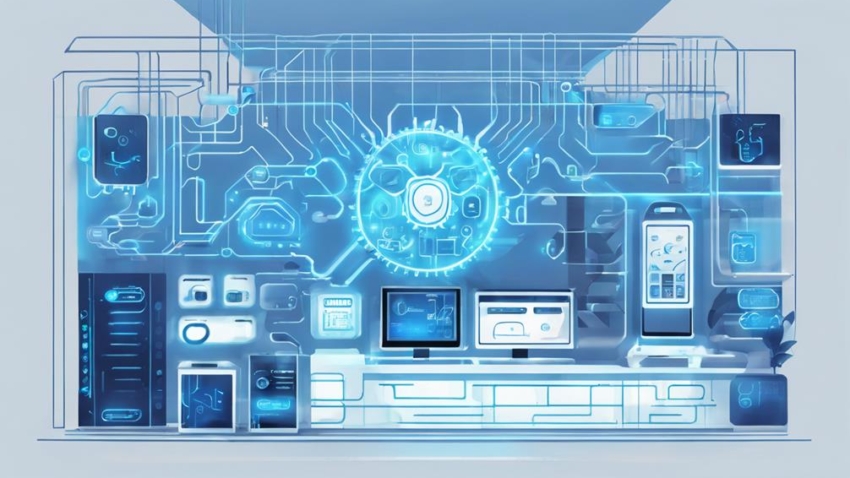
Revolutionizing Customer Experience With Iot
The integration of IoT technology is revolutionizing the customer experience by providing businesses with unprecedented levels of real-time data. This enables them to create personalized interactions, streamline operations, and enhance in-store shopping experiences. With IoT, businesses can gather detailed customer insights, track behavior, and tailor interactions to individual preferences and behaviors. By leveraging IoT-enabled solutions, companies can improve operational efficiency, reduce costs, and increase customer satisfaction. As businesses continue to harness the power of IoT, they will uncover new opportunities to transform the customer experience, leading to unparalleled levels of loyalty and retention.
Unlocking Real-Time Customer Insights
Accessing Real-Time Customer Insights
By harnessing the vast amounts of data generated by IoT devices, businesses can tap into a treasure trove of vital customer insights, enabling them to respond promptly to shifting preferences and behaviors. This wealth of data provides unparalleled opportunities for businesses to create detailed customer profiles, allowing them to understand their target audience like never before. Through advanced analytics and machine learning algorithms, businesses can analyze vast amounts of data to identify patterns, trends, and correlations that were previously unknown.
Customer profiling, an essential aspect of IoT-driven customer insights, enables businesses to create detailed and accurate profiles of their customers. By analyzing data from IoT devices, businesses can gather information on customer preferences, behaviors, and pain points, allowing them to create personalized experiences that meet their customers' unique needs. Sentiment analysis, another key application of IoT data, enables businesses to gauge customer sentiment and emotions, providing valuable insights into customer satisfaction and loyalty.
With real-time customer insights, businesses can respond promptly to customer needs, preferences, and concerns, fostering a deeper understanding and connection with their target audience. By leveraging IoT data, businesses can stay ahead of the competition, drive innovation, and create exceptional customer experiences that drive loyalty and retention.
Personalizing Interactions With Smart Devices
As businesses leverage real-time customer insights to better understand their target audience, they can now take the next step by utilizing smart devices to create personalized interactions that cater to individual customer needs. By integrating IoT technology into their customer experience strategy, companies can create tailored experiences that resonate with their customers on a deeper level.
To achieve this level of personalization, businesses can employ the following strategies:
- Context awareness: Use IoT sensors to gather data on environmental factors such as temperature, humidity, and lighting, allowing for a more nuanced understanding of customer behavior and preferences.
- Device profiling: Create detailed profiles of customers based on their device usage patterns, enabling companies to tailor their interactions to individual preferences and behaviors.
- Real-time analytics: Leverage IoT data to analyze customer behavior in real-time, enabling businesses to respond promptly to changing customer needs and preferences.
- Dynamic content delivery: Use IoT data to deliver targeted, dynamic content that resonates with individual customers, increasing engagement and loyalty.
Streamlining Operations for Efficiency
As businesses seek to revolutionize customer experience with IoT, they must also focus on optimizing internal processes to achieve operational excellence. By leveraging IoT-enabled technologies, companies can streamline their operations, reduce inefficiencies, and improve overall productivity. By examining smart supply chain management, real-time inventory tracking, and automated workflows optimization, businesses can access new levels of efficiency and responsiveness.
Smart Supply Chain Management
By integrating IoT sensors and data analytics into logistics operations, companies can greatly reduce transit times, increase shipment visibility, and minimize the risk of inventory loss or damage. This digital transformation of supply chain management enables businesses to respond quickly to changes in demand, ensuring that products reach customers on time and in pristine condition.
Smart supply chain management, powered by IoT, offers numerous benefits, including:
- Real-time monitoring: IoT sensors provide real-time insights into shipment location, temperature, and humidity, enabling proactive measures to prevent damage or spoilage.
- Predictive maintenance: IoT-enabled logistics operations can detect potential equipment failures, reducing downtime and increasing overall supply chain resilience.
- Optimized routes: IoT data analytics helps optimize routes, reducing fuel consumption, and lowering carbon emissions.
- Improved customer satisfaction: With IoT-enabled supply chain management, businesses can provide customers with accurate delivery times and updates, enhancing the overall customer experience.
Real-time Inventory Tracking
Effective inventory management relies heavily on real-time tracking capabilities, which IoT technology can provide, enabling businesses to maintain accurate stock levels, reduce stockouts, and streamline operations for enhanced efficiency. With IoT-enabled sensors and RFID tags, businesses can automate inventory tracking, eliminating manual errors and ensuring that stock levels are updated in real-time. This level of precision enables businesses to optimize their warehouse operations, reducing congestion and increasing the speed of order fulfillment. Inventory automation also enables businesses to identify slow-moving or dead stock, allowing for informed decisions on inventory optimization and reduction of waste. By leveraging IoT technology, businesses can achieve warehouse optimization, reducing costs associated with inventory holding and minimizing the risk of stockouts. With real-time inventory tracking, businesses can take control of their inventory management, making data-driven decisions to drive operational efficiency and enhance customer satisfaction.
Automated Workflows Optimization
IoT technology also enables the creation of automated workflows, allowing businesses to streamline their operations and eliminate inefficiencies, thereby reducing costs and improving overall productivity. By automating workflows, companies can optimize their processes, reducing the need for manual intervention and minimizing the risk of human error. This, in turn, enables businesses to focus on high-value tasks that drive innovation and growth.
Automated workflows can be optimized in several ways:
- Process Automation: Automating repetitive tasks and processes, freeing up staff to focus on strategic initiatives.
- Task Prioritization: Prioritizing tasks based on urgency and importance, ensuring that critical tasks are completed efficiently.
- Real-time Monitoring: Monitoring workflows in real-time, enabling swift response to issues and bottlenecks.
- Predictive Maintenance: Predicting and preventing equipment failures, reducing downtime and increasing overall efficiency.
Enhancing In-Store Shopping Experiences
Retailers are increasingly leveraging IoT sensors and data analytics to create personalized, immersive experiences that drive customer engagement and loyalty in physical stores. By harnessing the power of IoT, retailers can transform the in-store shopping experience, making it more engaging, interactive, and tailored to individual preferences.
One innovative application of IoT in retail is virtual fitting. Using IoT-enabled virtual try-on solutions, customers can digitally try on clothes without having to physically change into them. This not only enhances the shopping experience but also reduces the likelihood of returns and increases sales. Moreover, IoT-enabled smart kiosks can provide customers with personalized product recommendations, offer real-time inventory checks, and enable seamless checkout processes.
IoT sensors can also be used to track customer behavior, providing valuable insights into shopping patterns and preferences. Retailers can then use this data to optimize store layouts, product placement, and marketing strategies, ultimately driving sales and revenue growth. By leveraging IoT technology, retailers can create a seamless, omnichannel shopping experience that combines the benefits of online and offline shopping, resulting in increased customer satisfaction and loyalty. As IoT continues to evolve, retailers that adopt this technology will be well-positioned to stay ahead of the competition and revolutionize the in-store shopping experience.
IoT-Enabled Predictive Maintenance
IoT-enabled predictive maintenance is a game-changer for businesses, allowing them to shift from reactive to proactive maintenance strategies. By leveraging real-time condition monitoring, businesses can identify potential equipment failures before they occur, thereby reducing downtime and increasing overall efficiency. This proactive approach enables companies to optimize their maintenance schedules, minimize costly repairs, and improve their bottom line.
Real-time Condition Monitoring
By harnessing real-time condition monitoring, businesses can shift from reactive to proactive maintenance strategies, significantly reducing downtime and increasing overall equipment effectiveness. This is achieved by continuously tracking device performance and sensor calibration, enabling swift identification of potential issues before they escalate into major problems.
Real-time condition monitoring offers numerous benefits, including:
- Enhanced predictive capabilities: IoT sensors provide real-time data, enabling accurate predictions of equipment failure, allowing for proactive maintenance scheduling.
- Reduced maintenance costs: By detecting potential issues early, businesses can avoid costly repairs and minimize downtime.
- Improved resource allocation: Real-time monitoring enables optimized resource allocation, ensuring the right personnel and equipment are deployed to address issues promptly.
- Increased customer satisfaction: By minimizing downtime and ensuring equipment is always operational, businesses can provide a seamless customer experience.
Proactive Fault Detection
As businesses continue to leverage real-time condition monitoring to optimize equipment performance, they can further enhance their maintenance strategies by implementing proactive fault detection, which enables the identification of potential faults before they occur. This proactive approach empowers organizations to take control of their maintenance operations, reducing the likelihood of unexpected downtime and increasing overall efficiency. By leveraging IoT-enabled predictive modeling, businesses can analyze real-time data to identify potential fault patterns, enabling proactive maintenance and minimizing the risk of equipment failure. This approach also facilitates failure analysis, allowing organizations to identify root causes of faults and implement corrective measures to prevent future occurrences. By integrating proactive fault detection into their maintenance strategies, businesses can guarantee maximum uptime, reduce maintenance costs, and improve overall customer satisfaction. With the ability to predict and prevent faults, organizations can regain control over their operations, guaranteeing seamless customer experiences and maintaining a competitive edge in the market.
Reduced Downtime Optimization
With predictive maintenance strategies in place, organizations can minimize equipment downtime by up to 50%, resulting in substantial reductions in operational costs and improvements in overall productivity. By leveraging IoT-enabled predictive maintenance, companies can shift from reactive to proactive maintenance, reducing downtime and increasing asset utilization.
Here are four key benefits of IoT-enabled predictive maintenance:
- Improved Asset Utilization: Predictive maintenance enables companies to maximize asset utilization, reducing downtime and increasing overall productivity.
- Enhanced Predictive Capabilities: Machine Learning algorithms can analyze real-time data to predict equipment failures, allowing for proactive maintenance and minimizing unexpected downtime.
- Reduced Maintenance Costs: By reducing the frequency of unexpected repairs, companies can significantly decrease maintenance costs and allocate resources more efficiently.
- Increased Customer Satisfaction: With reduced downtime, companies can improve customer satisfaction by ensuring timely delivery of products and services.
Revolutionizing Supply Chain Management
Revolutionizing Supply Chain Management
Supply chain inefficiencies, a perpetual thorn in the side of businesses, are being alleviated through the strategic integration of IoT technologies. By leveraging IoT, companies can gain unparalleled visibility into their supply chain operations, enabling them to identify and address bottlenecks, reduce costs, and improve overall efficiency.
One critical area where IoT is making a significant impact is in freight visibility. IoT sensors and tracking devices provide real-time insights into shipment locations, temperatures, and conditions, enabling businesses to proactively respond to disruptions and optimize their logistics operations. This level of visibility also enables companies to improve their inventory management, reduce stockouts, and enhance their overall customer satisfaction.
Another area where IoT is transforming supply chain management is in warehouse robotics. IoT-enabled warehouse robots can navigate and interact with their environment, streamlining tasks such as inventory management, order picking, and packaging. These robots can also be equipped with IoT sensors, enabling them to detect and respond to changes in their environment, further improving their efficiency and accuracy. By integrating IoT technologies into their supply chain operations, businesses can gain a competitive edge, improve their bottom line, and deliver exceptional customer experiences.
Creating Immersive Customer Journeys
As we delve into the domain of Creating Immersive Customer Journeys, it becomes evident that designing personalized experiences and seamlessly integrating touchpoints are essential elements in crafting memorable interactions. By leveraging IoT capabilities, businesses can tailor their offerings to individual preferences, fostering deeper connections with their customers. This harmonious union of technology and customer-centric design enables the creation of truly immersive experiences that leave a lasting impression.
Personalized Experience Design
By harnessing the power of IoT-enabled data, businesses can craft bespoke customer experiences that converge physical and digital touchpoints, yielding immersive journeys that leave a lasting impression. This personalized approach enables companies to create contextual storytelling, evoking emotional resonance that fosters deep connections with their audience.
To achieve this, businesses can focus on the following key aspects:
- Data-driven profiling: Leverage IoT data to create detailed customer profiles, highlighting preferences, behaviors, and pain points.
- Contextual messaging: Use IoT-enabled data to craft targeted, personalized messages that resonate with customers in real-time.
- Dynamic experience mapping: Create dynamic, adaptive experiences that adapt to customer interactions, preferences, and behaviors.
- Real-time feedback loops: Establish closed-loop systems that continuously gather feedback, enabling businesses to refine and optimize customer experiences.
Seamless Touchpoint Integration
Seamless touchpoint integration is pivotal in creating immersive customer journeys, where IoT-enabled devices and sensors harmoniously converge to orchestrate a cohesive, omnichannel experience. By integrating various touchpoints, businesses can create unified experiences that smoothly shift between online and offline channels, providing customers with a frictionless journey. This convergence enables the creation of personalized, context-aware interactions that cater to individual preferences and behaviors.
Through IoT-enabled devices and sensors, businesses can gather valuable insights into customer behavior, preferences, and pain points, allowing for tailored interactions that foster loyalty and trust. By eliminating silos and disconnects between touchpoints, businesses can guarantee a seamless flow of information, providing customers with a cohesive and intuitive experience. This, in turn, enables businesses to build strong, long-term relationships with their customers, driving loyalty, retention, and ultimately, revenue growth. By harnessing the power of IoT, businesses can revolutionize customer experience, creating immersive journeys that leave a lasting impression.
IoT's Role in Remote Customer Support
Leveraging IoT-enabled devices, businesses can tap into real-time data to remotely diagnose and troubleshoot customer issues, reducing the need for on-site visits and resulting in faster resolution times. This shift towards remote customer support enables companies to take a more proactive approach, resolving problems before they escalate and improving overall customer satisfaction.
By leveraging IoT data, businesses can:
- Proactively identify potential issues, allowing for swift resolution and minimizing downtime.
- Implement virtual assistants that provide customers with personalized support and guidance.
- Deploy proactive chatbots that offer real-time solutions and reduce the need for human intervention.
- Analyze customer behavior, enabling businesses to tailor their support services to meet specific needs and preferences.
Smart Homes and Seamless Experiences
In a world where smart home devices are becoming increasingly prevalent, companies are presented with a unique opportunity to create unparalleled customer experiences by integrating their products and services with these devices. By doing so, businesses can create seamless interactions that cater to the specific needs and preferences of their customers. For instance, smart lighting systems can be programmed to adjust brightness and color based on the time of day, creating a customized ambiance that enhances the overall customer experience.
The integration of voice assistants, such as Amazon Alexa or Google Assistant, takes this personalization to the next level. Customers can effortlessly control their smart home devices, access information, and receive tailored recommendations, all through voice commands. This hands-free interaction enables customers to multitask, making their lives easier and more convenient. Furthermore, companies can leverage these interactions to gather valuable insights on customer behavior, preferences, and pain points, allowing them to refine their offerings and improve customer satisfaction.
IoT-Powered Customer Feedback Systems
One of the most significant advantages of IoT technology is its ability to facilitate the collection of real-time customer feedback, enabling businesses to respond promptly to customer concerns and preferences. This real-time feedback allows companies to gain a deeper understanding of customer sentiment, enabling them to tailor their offerings to meet the evolving needs of their customers.
IoT-powered customer feedback systems can help businesses develop emotional intelligence by providing insights into customer emotions and behaviors. This emotional intelligence enables companies to create personalized experiences that resonate with their customers, fostering loyalty and driving business growth.
Here are 4 key benefits of IoT-powered customer feedback systems:
- Real-time Insights: IoT technology enables businesses to collect and analyze customer feedback in real-time, allowing for prompt responses to customer concerns.
- Personalized Experiences: IoT-powered feedback systems provide businesses with the insights needed to create personalized experiences that meet the unique needs and preferences of their customers.
- Emotional Intelligence: IoT technology helps businesses develop emotional intelligence by providing insights into customer emotions and behaviors.
- Data-Driven Decision Making: IoT-powered feedback systems provide businesses with actionable data, enabling them to make data-driven decisions that drive business growth and improvement.
Unlocking New Revenue Streams
By harnessing the power of IoT, businesses can tap into previously unrealized revenue potential, uncovering new opportunities to monetize their products and services in innovative ways. IoT enables companies to collect and analyze vast amounts of data, providing valuable insights that can be leveraged to create new revenue streams.
One such opportunity lies in dynamic pricing, where IoT-enabled sensors and devices provide real-time data on usage patterns, allowing businesses to adjust their pricing strategies accordingly. This approach enables companies to optimize their revenue by charging premium rates during peak usage periods and offering discounts during off-peak times.
Another significant revenue stream is data monetization. IoT devices generate vast amounts of data, which can be sold to third-party organizations, providing valuable insights for their business operations. Additionally, IoT data can be used to develop new services, such as predictive maintenance, energy management, and supply chain optimization, creating new revenue streams for businesses.
Frequently Asked Questions
Can Iot Devices Compromise Customer Data Privacy?
Furthermore, the proliferation of IoT devices raises concerns about customer data privacy. Indeed, IoT devices can compromise customer data privacy if not properly secured. Unencrypted data transmission and storage can expose sensitive information to cyber threats. Additionally, network vulnerabilities can provide an entry point for hackers to access and exploit customer data. To mitigate these risks, robust data encryption and secure network protocols are essential to safeguard customer data and maintain trust.
How Do Iot-Enabled Devices Improve Customer Engagement?
Ironically, the very devices that raise concerns about data privacy can also be the key to unleashing unparalleled customer engagement. IoT-enabled devices facilitate personalized interactions by providing real-time insights into customer behavior and preferences. This allows businesses to craft targeted, relevant responses that resonate with individuals, fostering a sense of being understood and valued. Through IoT, companies can deliver timely, context-specific communications that drive meaningful connections and loyalty.
Are Iot-Powered Solutions Cost-Prohibitive for Small Businesses?
For small businesses, adopting IoT-powered solutions often raises concerns about cost considerations. Financial constraints can be a significant barrier to entry, as implementation and maintenance costs can be substantial. While IoT technology offers numerous benefits, small businesses must carefully weigh the potential returns against the initial investment. It's essential to assess the total cost of ownership, including hardware, software, and ongoing support, to determine whether IoT-powered solutions are viable for their operations.
Can Iot-Enabled Predictive Maintenance Reduce Downtime?
Optimizing operations and minimizing disruptions are essential for businesses of all sizes. Can IoT-enabled predictive maintenance reduce downtime? The answer lies in harnessing the power of Machine Learning and real-time analytics. By leveraging these technologies, companies can detect potential issues before they occur, schedule maintenance during ideal windows, and guarantee seamless operations. With IoT-enabled predictive maintenance, businesses can regain control, minimize downtime, and maximize productivity.
Do Iot-Powered Feedback Systems Improve Customer Retention Rates?
Implementing IoT-powered feedback systems can greatly enhance customer retention rates. By leveraging real-time insights from IoT devices, businesses can create personalized interactions that cater to individual customer needs. This targeted approach fosters a sense of ownership and control, leading to enhanced customer satisfaction and loyalty. As a result, businesses can reduce churn rates and build long-term relationships with their customers.











